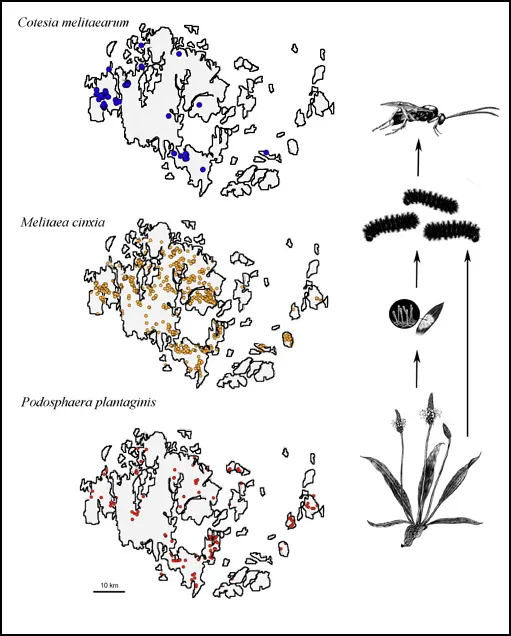Research Topics
Multitrophic interactionsMultitrophic interactions

van Nouhuys, S. & Hanski, I. 2002. Multitrophic interactions in space: metacommunity dynamics in fragmented landscapes. In Multitrophic level interactions (T. Tscharntke & B. A. Hawkins eds.) Cambridge University Press. pp. 124-147
We study direct and indirect interactions among species, mostly using:
Plants: Plantago lanceolata & Veronica spicata
Herbivores: Melitaea cinxia & Melitaea athalia
Parasitoids: Cotesia melitaearum, Hyposoter horticola, Pteromalus apum
Hyperparasitoids: Gelis agilis & Mesochorus stigmaticus
Chemical Ecology: Iridoid glycosides
Plant-herbivore:
Reudler Talsma, J., Biere, A., Harvey, J. A., van Nouhuys, S.2011 Oviposition cues for a specialist butterfly: plant chemistry and size. Journal of chemical Ecology, 37: 765-778
Reudler Talsma, J., Torri, K. van Nouhuys, S. 2008 Host plant use by the Heath fritillary butterfly, Melitaea athalia : plant habitat, species and chemistry. Arthropod-Plant Interactions, 2: 63-75
Saastamoinen, M., van Nouhuys, S., Nieminen, M., O’Hara, B., Suomi, J. 2007. Development and survival of a specialist herbivore, Melitaea cinxia, on host plants producing high and low concentrations of iridoid glycosides. Annales Zoologici Fennici, 44: 70-80
van Nouhuys, S., M.C. Singer, M. Nieminen. 2003. Spatial and temporal patterns of caterpillar performance and the suitability of two host plant species Ecological Entomology, 28: 193-202
Plant-herbivore-parasitoid:
Reudler J. H., van Nouhuys, S. 2018. The roles of foraging environment, host species and host diet for a generalist pupal parasitoid.Entomologia Experimentalis et Applicata 10.1111/eea.12657
Kaiser, L., Ode, P., van Nouhuys, S., Calatayud, P., Colazza, S., Cortesero, A., Thiel, A., van Baaren, J. 2016. The plant as a habitat for entomophagous insects in Plant-Insect interations (eds. Sauvion, N., Calatayud, P., and Thiery, D.). Advances in Botanical Research Volume 81. http://dx.doi.org/10.1016/bs.abr.2016.09.006
Reudler, J. H., Biere, A., Harvey, J. A., van Nouhuys, S. 2011. Differential performance of a specialist and two generalist herbivores and their parasitoids on Plantago lanceolata. Journal of Chemical Ecology, 37: 765-778
Harvey, J.A., van Nouhuys, S., Biere, A. 2005. Effects of quantitative variation in allelochemicals in Plantago lanceolata on development of a generalist and a specialist herbivore and their endoparasitoids. Journal of Chemical Ecology, 31: 287-302
Nieminen, M., J. Suomi, S. van Nouhuys, P. Sauri, M. Riekkola 2003. Effect of iridoid glycoside content on oviposition host plant and parasitism in a specialist herbivore. Journal of Chemical Ecology, 29: 823-844
Plant-herbivore-parasitoid-hyperparasitoid:
van Nouhuys, S., Reudler, J. H., Biere, A., Harvey, J. A. 2012. Performance of secondary parasitoids on chemically defended and undefended hosts. Basic and Applied Ecology, 13: 241-249
van Nouhuys, S., Reudler, J. H., Biere, A., Harvey, J. A. 2012. Performance of secondary parasitoids on chemically defended and undefended hosts. Basic and Applied Ecology, 13: 241-249
Chemical Ecology: Volatile organic chemicals
Pinto-Zevallos, D. M., H. Hellén, et al. 2013. Induced defenses of Veronica spicata: Variability in herbivore-induced volatile organic compounds. Phytochemistry Letters 6(4): 653-656.
Castelo, M. K., van Nouhuy, S., Corley, J. C. 2010. Olfactory attraction of the larval parasitoid, Hyposoter horticola, to plants infested with eggs of the host butterfly, Melitaea cinxia . Journal of insect Science, Vol. 10, article 53
Multitrophic interations
Kahilainen, A., van Nouhuys, S., Schulz, T. & Saastamoinen, M. 2018 Metapopulation dynamics in a changing climate: Increasing spatial synchrony in weather conditions drives metapopulation synchrony of a butterfly inhabiting a fragmented landscape.
Global Change Biology, 24: 10.1111/gcb.14280
Nair, A., Nonaka , E., van Nouhuys, S. 2018
Increased fluctuation in a butterfly metapopulation leads to diploid males and decline of a hyperparasitoid Proceedings of the Royal Society B, 285: 10.1098/rspb.2018.0372
Rasmussen, P. U., Amin, T., Bennett, A. E., Karlsson Green, K., Timonen, S., van Nouhuys, S., Tack, A. J. M. 2017. Plant and insect genetic variation mediate the impact of arbuscular mycorrhizal fungi on a natural plant-herbivore interaction. Ecological Entomology, 42 793-802
Duplouy, A., Couchoux, C., Hanski, I., van Nouhuys, S. 2015 Wolbachia infection in a natural parasitoid wasp population. PLOS One, 10(8): e0134843. doi:10.1371/journal.pone.0134843
Saastamoinen, M., Hirai, N., van Nouhuys, S. 2013. Direct and trans-generational responses to food deprivation during development in the Glanville fritillary butterfly.
Oecologia, 171: 93-104
van Nouhuys, S. and Laine, A-L. 2008 Population dynamics and sex ratio of a parasitoid altered by fungal infected diet of host butterfly Proceedings of the Royal Society B , 275: 377-385
van Nouhuys, S. & I. Hanski. 1999. Host diet affects extinctions and colonizations in a parasitoid metapopulation. Journal of Animal Ecology, 68: 1248-125

